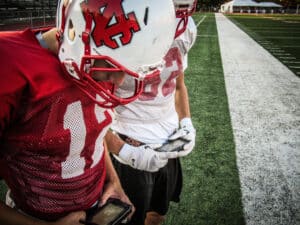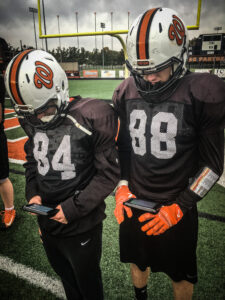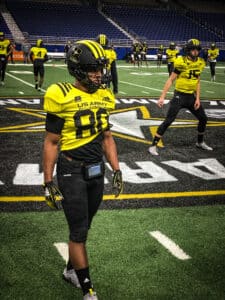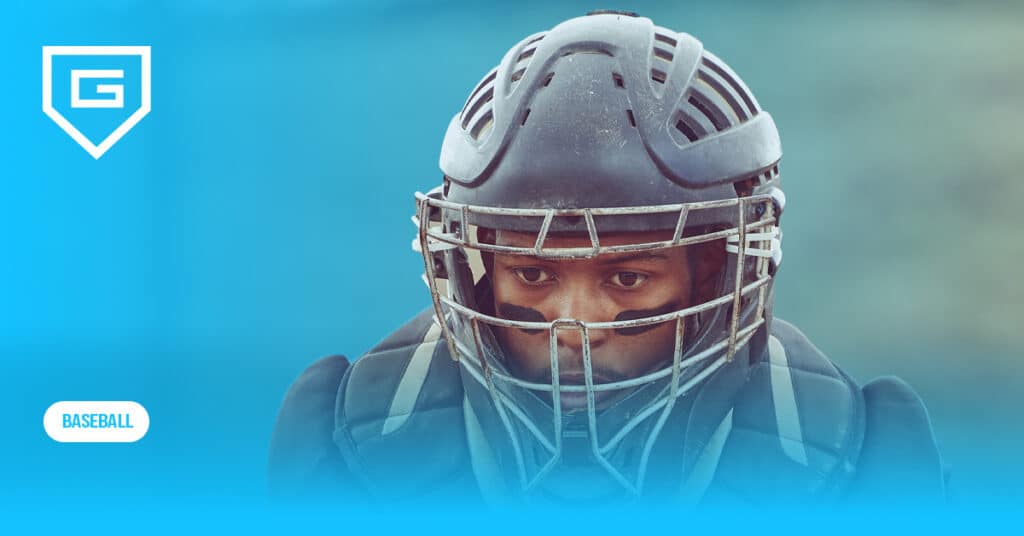Football Helmet Technology: Innovations Transforming the Game
Reading Time: 7 minutes
Reading Time: 7 minutes
Football helmets have come a long way from the leather caps of the early 1900s. Today, football helmet technology is at the forefront of player safety, combining cutting-edge technology with advanced materials to protect athletes from head injuries and concussions. Whether you’re watching NFL players on Sunday or coaching at the high school or collegiate levels, helmets now offer more than just protection—they’re tools for development, comfort, and even performance analytics.
In this article, we’ll explore how innovations in helmet technology are improving safety in contact sports, the role of biomechanical engineers in helmet design, and the impact that helmet technology has had on team strategy and coaching.
A Brief History of Football Helmet Design

In the late 1800s, football helmets were little more than soft leather caps designed to reduce bruising. Fast forward to the mid-20th century, and the introduction of plastic shells, face masks, and padding redefined helmet safety. Position-specific helmets, like those tailored for quarterbacks, began emerging as engineers and medical experts prioritized reducing the risk of head trauma.
Key Milestones in Helmet Development:
- 1950s: Face masks and padding were introduced, adding crucial protection for the jaw and head.
- 1980s: Polycarbonate shells replaced fiberglass, offering better impact resistance.
- Today: Features like impact testing, energy-absorbing liners, and smart sensors are common, keeping players safer than ever before.
With these advancements, football helmets continues to evolve, combining desires for improved safety with performance-enhancing capabilities.
How Modern Helmet Technology Enhances Safety

The Role of Advanced Materials
Modern helmets are crafted with thermoplastics, viscoelastic foams, and other materials designed to absorb and redistribute impact forces. These materials are rigorously tested by biomechanical engineers to ensure they meet the highest standards in player safety.
- Outer Shell: Polycarbonate shells are lightweight yet strong enough to withstand the many hits they take during a game.
- Inner Padding: Foam padding compresses under pressure to reduce head movement during impact.
- Face Masks: Made from stainless steel or titanium, these offer durability without compromising vision for players.
Smart Sensors and Impact Monitoring
The integration of sensors into football helmets is one of the most exciting advancements in the sport. These sensors measure impact forces, providing real-time data that allows coaches and medical staff to monitor athletes for signs of potential head injuries.
How It Works:
- Sensors inside the helmet detect and measure the severity of impacts.
- Data is sent to medical experts or coaches, who can assess whether a player needs further evaluation.
- By preventing players from continuing after a high-impact hit, these helmet safety systems help reduce the risk of concussions.
Modern Football Helmet Components

Wearing modern football helmets is crucial to player safety. When deciding which to add to your football practice plan this fall, you must understand the components. The primary objective of modern helmet design is to protect athletes from brain injury.
Outer shell
The outer shell of modern football helmets is typically polycarbonate—a lightweight, very durable plastic. It can withstand and distribute the impact force in contact sports. Polycarbonate allows existing helmets to take multiple hits without cracking. This is better than old materials like leather and fiberglass.
Inner padding
Inner foam padding is made of vinyl nitrile or EVA foam to absorb shock and cushion the athlete’s head. Biomechanical engineers design this padding to fit the player’s head, make it comfortable, and reduce head movement during impact to keep players safe. It compresses under pressure and then goes back to its original shape.
Facemask
The facemask is stainless steel or titanium and protects the face while giving visibility and vision to the athlete. Titanium, for example, is a lighter option with the same strength. Engineers designing facemasks focus on withstanding strong impacts to protect the face without bending or breaking.
Chin strap
A chin strap keeps the helmet in place during play. It’s made of durable synthetic material like polypropylene so that it won’t move during fast movements. The development of these materials keeps the helmet snug and secure.
Air management systems
A helmet designed with the latest advancements has air management systems for customizable fit by inflating or deflating the air bladder inside the helmet. Another layer of head comfort and a tighter fit for athletes.
Cutting-Edge Innovations in Football Helmet Technology
What’s New in Helmet Development?
The latest advancements in football helmet technology are reshaping the way we approach player safety:
- 3D-Printed Custom Fits: Helmets are now designed using scans of a player’s head, creating a perfect fit for improved comfort and safety.
- Flexible Outer Shells: These allow helmets to flex on impact, reducing force transfer to the skull.
- Liquid Shock Absorbers: Research at Stanford University revealed that liquid-filled liners can reduce impact forces by up to 33%.
These new ideas are pushing the boundaries of what helmets can do, with researchers and engineers continuously exploring continued advancements.
The Role of Helmets in Reducing Concussions
Despite all the innovations, no helmet can fully prevent concussions. However, modern helmets significantly reduce the likelihood and severity of such injuries. Impact testing and collaboration with medical experts ensure that helmets meet rigorous standards.
Key Elements for Concussion Prevention:
- Proper fit and secure chin straps.
- Regular inspection for wear and tear.
- Education on proper tackling techniques.
By combining technology with education, players can better protect themselves from injury. Both of these elements are crucial to executing a football practice plan and ensuring player development and safety.
The Future of Football Helmet Technology
What’s on the Horizon?
With the rise of wearable technology in sports and the increased use of sports coaching technology, football helmets have come a long way in improving player safety and performance. The trends that we are seeing with football helmet technology aren’t slowing. Here is what you can look forward to in the future:
Future Innovations:
- Augmented Reality (AR) Displays: Helmets with AR overlays to enhance situational awareness during a game.
- Graphene Materials: Ultra-strong and lightweight, graphene could revolutionize helmet construction.
- Integrated Data Systems: Real-time health monitoring for athletes, including hydration and heart rate.
Football’s total investment in safety is also driving collaboration with universities and engineers, ensuring that the future of helmets prioritizes both safety and performance.
The Broader Impact on Coaching and Strategy
How Helmet Technology Changes the Game
For coaches, the adoption of advanced football helmet technology also means rethinking their strategy. While the incredible player-safety driven developments outlined above are considered by coaches, the more immediate benefit of helmet technology is coach-to-player communication systems.
In 2024, college football adopted helmet communication. This allows coaches to verbally give play calls to a player on the field through a speaker in their helmet. It has helped teams to evolve from old-school methods of play calling through signs and hand signals to a more professional and streamlined system.
The inclusion of in-helmet audio in college football has minimized sign stealing, and improved the overall competitive experience. However, the cost of these audio solutions is a challenge for many programs facing a tight budget. GoRout Gridiron is an alternative, wearable communication solution for teams at all levels.
Get a quote today.
GoRout: The Best Alternative for Coach-to-Player Communication
GoRout’s in-game football solution is improving coach-to-player communication on the field.
GoRout football play-calling system lets coaches send play calls and strategic adjustments directly to players’ wearable devices through secure, real-time communication. It eliminates sign stealing with 128-bit encryption, so all play calls are protected. Each device has 4-way small LED screens for extreme privacy.

GoRout also offers football practice devices to streamline communication and increase practice efficiency. These football wristbands protect teams’ play-calling strategies with secure play delivery and result in double reps at practice.
Get a quote today.
The Future of Football Helmet Technology

The future of football helmet technology promises groundbreaking advancements that will make the game safer and more data-centric than ever before.
- Smart helmets equipped with real-time medical data collection capabilities
- Use of graphene and nano-engineered polymers for superior safety features
- Integration of Augmented Reality (AR) displays for increased situational awareness
- Custom 3D-printed helmets tailored to individual player needs
Researchers and engineers are discovering new developments in wearable technology and materials that will protect the athletes and lead to better performance.
Conclusion: Shaping the Future of Football
Football helmet technology has revolutionized the way American football players approach the game. By prioritizing safety and incorporating cutting-edge technology, these innovations protect athletes while enhancing performance.
As research and development continue, the future promises even greater advancements, ensuring that helmets remain an essential part of player safety in contact sports. By embracing these technologies, coaches and teams can foster a safer, more competitive environment.
FAQs About Football Helmet Technology
What is the latest innovation in football helmet technology?
Recent advancements include 3D-printed custom fits, liquid shock absorbers, and flexible outer shells, all aimed at reducing the risk of injury.
How does helmet technology prevent concussions?
Modern helmets use advanced materials and sensors to absorb and monitor impact forces, helping to prevent and manage concussions.
Are position-specific helmets worth the investment?
Yes, position-specific helmets provide tailored protection for unique demands, such as quarterbacks needing mobility and linemen needing impact resistance.
How do I choose the right helmet for my team?
Work with coaches, equipment managers, and medical experts to select helmets that prioritize fit, material quality, and safety features.







